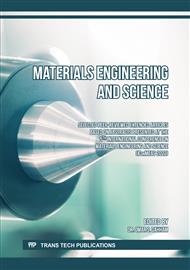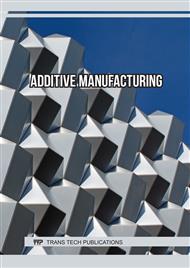[1]
A.P. de Silva, T.P. Vance, M.E. West, G.D. Wright, Bright molecules with sense, logic, numeracy and utility, Org Biomol Chem. 6 (2008) 2468-2480.
DOI: 10.1039/b802963f
Google Scholar
[2]
J. Mannekutla, B. Mulimani, S. Inamdar, Solvent effect on absorption and fluorescence spectra of coumarin laser dyes: evaluation of ground and excited state dipole moments, Spectrochim Acta A Mol Biomol Spectrosc. 69 (2008) 419-426.
DOI: 10.1016/j.saa.2007.04.016
Google Scholar
[3]
R.M.L. Christie, Chih-Hung, Studies of fluorescent dyes: part 1. An investigation of the electronic spectral properties of substituted coumarins, Dyes Pigm. 42 (1999) 85-93.
DOI: 10.1016/s0143-7208(99)00012-1
Google Scholar
[4]
J. Sokołowska, W. Czajkowski, R. Podsiadły, The photostability of some fluorescent disperse dyes derivatives of coumarin, Dyes Pigm. 49 (2001) 187-191.
DOI: 10.1016/s0143-7208(01)00018-3
Google Scholar
[5]
L. Liu, Y. Sun, S. Wei, X. Hu, Y. Zhao, J. Fan, Solvent effect on the absorption and fluorescence of ergone: Determination of ground and excited state dipole moments, Spectrochim Acta A Mol Biomol Spectrosc. 86 (2012) 120-123.
DOI: 10.1016/j.saa.2011.10.016
Google Scholar
[6]
S.A. Patil, P.S. Kadolkar, M.N. Wari, S.R. Inamdar, Photo-physical study of coumarins in aqueous organic solvents: an experimental and theoretical approach, Mater. Today Commun. 29 (2021) 102733.
DOI: 10.1016/j.mtcomm.2021.102733
Google Scholar
[7]
S. Ramsey, T. Mayo, S. Lambrakos, Novel Optical Systems, Methods, and Applications XXIII, SPIE2020, pp.183-190.
Google Scholar
[8]
S. Bagchi, Solvation in homogeneous and heterogeneous media, J Indian Chem Soc. 98 (2021) 100071.
Google Scholar
[9]
C. Reichardt, T. Welton, Solvents and solvent effects in organic chemistry, John Wiley & Sons (2011).
Google Scholar
[10]
I.F. Al-sharuee, Thermal Conductivity Performance of Silica Aerogel after Exposition on Different Heating under Ambient Pressure, Baghdad Sci J. 16 (2019) 0770-0770.
DOI: 10.21123/bsj.2019.16.3(suppl.).0770
Google Scholar
[11]
C. Reichardt, Solvation Effects in Organic Chemistry: A Short Historical Overview, J Org Chem. 87 (2022) 1616-1629. 10.1021/acs.joc.1c01979.
DOI: 10.1021/acs.joc.1c01979
Google Scholar
[12]
I.K. Mohammed, Study of Solvent Effects on the Uv/Visible Spectra of A Newly Synthesized Azo-Dye5-(8-Quinaldinolazo)-Para Phenyl Acetic Acid, Indian J F Med Tox. 13 (2019).
DOI: 10.5958/0973-9130.2019.00416.x
Google Scholar
[13]
K.H. Ibnaouf, A.O. Elzupir, M.S. AlSalhi, A.S. Alaamer, Influence of functional groups on the photophysical properties of dimethylamino chalcones as laser dyes, Opt Mater. 76 (2018) 216-221.
DOI: 10.1016/j.optmat.2017.12.034
Google Scholar
[14]
I. Georgieva, T. Zahariev, A.J. Aquino, N. Trendafilova, H. Lischka, Energy transfer mechanism in luminescence Eu (III) and Tb (III) complexes of coumarin-3-carboxylic acid: A theoretical study, Spectrochim. Acta A Mol Biomol Spectrosc. 240 (2020) 118591.
DOI: 10.1016/j.saa.2020.118591
Google Scholar
[15]
C. Maridevarmath, L. Naik, G. Malimath, Dielectric, Photophysical, Solvatochromic, and DFT Studies on Laser Dye Coumarin 334, BrJPh. 49 (2019) 151-160.
DOI: 10.1007/s13538-018-00628-3
Google Scholar
[16]
S. Nad, H. Pal, Photoinduced electron transfer from aliphatic amines to coumarin dyes, J chem phy. 116 (2002) 1658-1670.
DOI: 10.1063/1.1415451
Google Scholar
[17]
H.M. Fahmy, H.M. Kandel, H.A. Al-Shamiri, N.A. Negm, A.H. Elwahy, M.T. Abou Kana, Spectroscopic Study of Solvent Polarity on the Optical and Photo-Physical Properties of Novel 9, 10-bis (coumarinyl) anthracene, J Fluoresc. 28 (2018) 1421-1430.
DOI: 10.1007/s10895-018-2317-1
Google Scholar
[18]
P. Bhavya, R. Melavanki, R. Kusanur, K. Sharma, V. Muttannavar, L. Naik, Effect of viscosity and dielectric constant variation on fractional fluorescence quenching analysis of coumarin dye in binary solvent mixtures, Luminescence. 33 (2018) 933-940.
DOI: 10.1002/bio.3492
Google Scholar
[19]
M.A. Musa, J.S. Cooperwood, M.O.F. Khan, A review of coumarin derivatives in pharmacotherapy of breast cancer, Curr Med Chem. 15 (2008) 2664-2679.
DOI: 10.2174/092986708786242877
Google Scholar
[20]
W.A. Woldie, Characterization of Dairy Waste Whey and Its' Utilization for the Production of Ethanol, Am J Chem Eng. 9 (2021) 112-118.
Google Scholar
[21]
O. Destanoğlu, İ. AteŞ, Determination and evaluation of methanol, ethanol and higher alcohols in legally and illegally produced alcoholic beverages, J Turkish Chem Soc, Sec A: Chem. 6 (2019) 21-28.
DOI: 10.18596/jotcsa.481384
Google Scholar
[22]
K. Sridhar, R. Murali, S.M. Younus, K.M. Lakshmi, Computerised Simulation of Spark Ignition Internal Combustion Engine, IOSR J Mech Civil Eng. (2013) 05-14p.
DOI: 10.9790/1684-0530514
Google Scholar
[23]
Z. Wang, C. Wang, Is breath acetone a biomarker of diabetes? A historical review on breath acetone measurements, J Breath Res. 7 (2013) 037109.
DOI: 10.1088/1752-7155/7/3/037109
Google Scholar
[24]
I.F. AL-Sharuee, Specifications study of Hydrophobic Silica Aerogel Doped with Rhodamine 6G Prepared via Sub-Critical Drying Technique, Iraqi J Sci. (2021) 483-489.
DOI: 10.24996/ijs.2021.62.2.14
Google Scholar
[25]
J. Catalán, J.L.G. de Paz, C. Reichardt, On the molecular structure and UV/vis spectroscopic properties of the solvatochromic and thermochromic pyridinium-N-phenolate betaine dye B30, J Phy Chem A. 114 (2010) 6226-6234.
DOI: 10.1021/jp1009302
Google Scholar
[26]
S. Zhu, H. Bao, H. Zhang, H. Fu, Q. Zhao, L. Zhou, Y. Li, W. Cai, Optimal excitation wavelength for surface-enhanced Raman spectroscopy: the role of chemical interface damping, J Phy Chem Lett. 12 (2021) 11014-11021.
DOI: 10.1021/acs.jpclett.1c03535
Google Scholar
[27]
R. Pikl, C. Fickert, W. Kiefer, Vibrational analysis and normal coordinate analysis of trimethylphosphane, Fresenius J Anal Chem. 355 (1996) 351-353.
DOI: 10.1007/s0021663550351
Google Scholar
[28]
N. Colthup, L. Daly, S. Wiberley, Introduction to Infrared and Raman Spectroscopy,Academic Press, New York,, (1990).
Google Scholar
[29]
N.C. D Lin-Vien, WG Fateley, JG Grasselli The Handbook of Infrared and Raman Characteristic Frequencies of Organic Molecules, Academic Press San Diego New York Boston London Sydney Tokyo Toronto1991.
DOI: 10.1016/b978-0-08-057116-4.50005-5
Google Scholar



